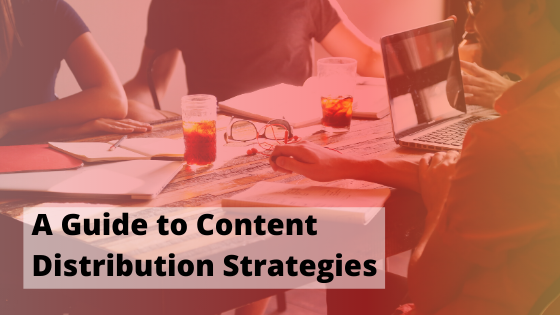
It doesn’t matter how valuable or engaging your content is, it’s not worth much if no one reads it (or if the wrong people read it). This brings us to a significant problem that content managers face today. Tons of new content appears online each day.
WordPress alone hosts 70 million new posts every month. As such, how well your content performs largely depends on getting your message in front of the right audience. If you want to drive a content marketing campaign that generates leads, you must have an effective content distribution strategy.
What Does Content Distribution Mean?
Content distribution refers to putting your content out to specific and targeted audiences (individuals and communities) where you increase your likelihood of engagement.
The keyword here is objectives. As opposed to sharing your content on as many platforms as possible (spray and pray), content distribution is about specific goals.
Here your focus is on targeting “high potential” users so that you can maximize your conversion rates and ultimately, content creation ROI. Your content distribution channels will typically fall into one of the following three categories:
- Owned Media Distribution – These are content distribution platforms that you own and control. They may include your website, blog, apps, newsletters, and email.
- Shared Media Distribution – These refer to social networking/media platforms where you post content in response to relevant consumer conversations. The owners of the platforms ultimately control your content marketing activities.
- Paid Content Distribution – These channels enable your brand to put out its message and control the platforms in which it appears, for a cost of course.
With content distribution, you have to determine if you are reaching the right people, if your message resonates with those people and if the relationships you build impact your business in a meaningful way.
So, how do you distribute content? You start by formulating an effective content distribution strategy.
What Are Distribution Strategies?
A content distribution strategy is a clearly documented framework that guides your content distribution efforts.
A distribution strategy provides structure to your content promotion process. This way, you can ensure that the valuable content you have invested in reaches the eyes you intend it to.
It is now easy to see why you should consider content distribution a pivotal part of your content marketing and not just an afterthought. In fact, your content distribution strategy should guide your content creation process.
A distribution strategy also ensures all parties in your team are on the same page. From brainstorming to creation to editing to content optimization, you have to align all aspects of the content marketing line for your overall strategy to be effective.
Finally, a distribution strategy allows you to determine key performance indicators (KPIs) and set benchmarks. These aspects are useful when it comes to measuring the performance of your hard work.
How Do You Write A Distribution Strategy?
When formulating your content distribution strategy, there are a few key guiding questions you need to ask yourself. These questions will help you establish where and how you’re going to reach your audience.
1. What is the goal behind every piece of content?
Every piece of content you create must have specific goals.
This could be to create brand awareness, increase user engagement or drive quality leads. For instance, if you operate an online store, what do you want your visitors to do?
Do you want them to only browse or purchase or do you also want them to sign up for email notifications of future store events and discounts? These goals will determine your content promotion efforts.
Also, consider some key triggers to insert in your content to push the readers to do what you want them to do.
A simple sentence such as, “Like this video? Remember to give it a thumbs up, subscribe and turn on notification.” It can be a good start if you’re having video content on YouTube and your goal is to grow your subscribers.
Instead, if your objective is to drive the video viewers to your website, you can add in a sentence like “Make sure to check out more information about this topic on our website.”
2. Who do you want to consume your content?
By understanding who you are trying to reach, you determine your target audience. You must develop a clear profile of your target audience. Without this, you won’t be able to optimize your content strategy for the right audience.
Do you want to reach out to c-suite executives in charge of business decision making (B2B)? Are you trying to reach out to millennials to harness their social sharing power to drive brand awareness? These questions will determine the type of content you create and the specific channels you will distribute it on.
To create a clear buyer persona, you must account for the psychographics and demographics of your target market. Psychographic data involves questions such as:
- How do they think?
- What are their likes, dislikes, and interests?
- What are their challenges and pain points?
- What are their goals?
Demographic data involves questions such as:
- What is their gender and age?
- Where do they stay?
- Are they married or single?
- What is their industry or niche, and what roles do they hold?
- What is their income
3. How does your audience consume content?
From your target audience’s profile, you can ascertain how they consume content. This allows you to go where they are and speak their language.
Do they mainly use their smartphones or are more likely to be on a laptop or desktop?
Do they prefer long-form articles or concise videos?
If your target audience prefers to consume content in picture form, for instance, it makes sense to reach out to them on Instagram or Pinterest. You can formulate your distribution strategy accordingly once you determine where, why and how your target audience consumes content.
According to your targeted audience, they also have different time periods where they’re more active. If those you target are office workers, and you’re trying to reach them through email, it will be wise to schedule the emails during the weekdays morning where they just clocked into work and checking on their mailbox.
For text-based content, you should consider: website/blog, e-book/pdf, newsletter/emails, LinkedIn, Reddit, Quora.
For videos, you can always go to: YouTube, Vimeo, Facebook, Instagram or their long-form video alternative IGTV.
For images, any social media sites will be suitable such as: Twitter, Pinterest, Instagram, Facebook and more.
Content Distribution Channels
The final component of your content distribution strategy is determining the distribution channels and how to create or repurpose your content to fit the platforms of choice.
1. Your Website/Blog
Your website or blog serves as the home base for your content traffic.
As such, you have to build a strong engaged audience and then expand to other channels to drive traffic your way and enhance this audience’s experience with your business.
A blog supports just about any type of content.
Aside from the conventional informative articles, you can create tutorials, eBooks, reviews, white papers, infographics, podcasts, and videos. One way you can extend your impact and reach is to periodically reuse your top-performing content.
If a piece of content is already resonating with your audience you can use several recycling techniques to extend its value:
- Republish – If the value of a content piece hasn’t diminished much since you published it, you can republish it and add new information. This ensures it makes its way back onto the radar of your audience.
- Repackage – You can deconstruct long-form content like eBooks, white papers, and blog posts into small, modular formats such as infographics or pictorials. This way the content may appeal to a different audience you are targeting.

At SEOPressor, we always keep our blog posts updated, and that is a good way to leverage existing content to be redistributed to keep it in sight of new visitors.
2. Email
Email is an effective distribution channel since it enables you to control what content you send, its core message and its custom marketing triggers.
The ideal first step is to create a newsletter list. You should already be doing this through Call-To-Actions (CTAs) on your website or blog, asking readers and visitors to subscribe to your blog and newsletter.
With newsletters, you are reaching people who are already interested in your offerings. Otherwise, they wouldn’t have subscribed. You can instantly deliver your message to nurture your prospects.
Send your subscribers your mid-funnel content such as white papers, eBooks, guides and infographics. You can also keep your audience updated on your latest offerings. Keep this to a minimum and make it useful. Ensure that you personalize your message by segmenting your email lists.
A great example of newsletter is the one from fame marketer, Seth Godin. He sends out a newsletter a day, always at the same time without fail. I would be lying if I said I’m not consciously refreshing my inbox when it’s time just to read his latest email. And that is newsletter done right.

3. Social Media
The most commonly used social media platforms for content distribution include Facebook, LinkedIn, Twitter, Instagram, and YouTube.
You have already conducted research and determined where your target audience spends their time. Create or repurpose your content for the relevant social platforms and post regularly.
For instance, if you are a B2C company that sells baby clothes to new mothers, you can research the social platforms that they typically use to source information. Are they more engaged on Facebook or they use Pinterest?
If they use Facebook often, creating video content around their interests can help you capture and drive their attention back to your own website. If they are more engaged on Pinterest and Instagram, high-quality pictures will do the trick.
4. Guest Posts
Guest blogging is a very effective inbound marketing strategy. Research from Social Marketing Writing reveals that 63% of internet users assign credibility to blogs with multiple authors. Many blogs are willing to accept a valuable in-depth guest post.
Guest blogging offers you authority, relevant backlinks, qualified user traffic and motivated leads. Ensure that you invite guest bloggers with a similar core message and objectives. Ideally, a guest blogger should provide a different perspective on the pain point of your target audience.
Here at SEOPressor we are always actively looking for knowledgeable
bloggers to share relevant information for our readers – which helps us
immensely in switching up the style and attracting more readers.
5. Paid Content Distribution Channels
Paid distribution channels complement your organic efforts and provide an extra layer of exposure to prospective audiences and your existing followers. You can distribute your content through paid channels on Facebook, Google, Instagram, Twitter, LinkedIn, Taboola or influencers.
Paid distribution can take many forms, but the main model is cost-per-click (CPC), where you pay a certain amount each time a user clicks through to view your content on the advertising platform.
Conclusion
You may have invested valuable resources and time into creating compelling content. However, without a plan to distribute it, your content marketing strategy is incomplete.
With all the available opportunities to increase the reach of your brand’s value, you have no excuse to let your assets wither in online obscurity. Select your content distribution channels based on topic, audience expectations, and intended results.
Here is an infographic to sum up all the available channels you should consider for your content distribution effort!

Updated: 6 January 2022







